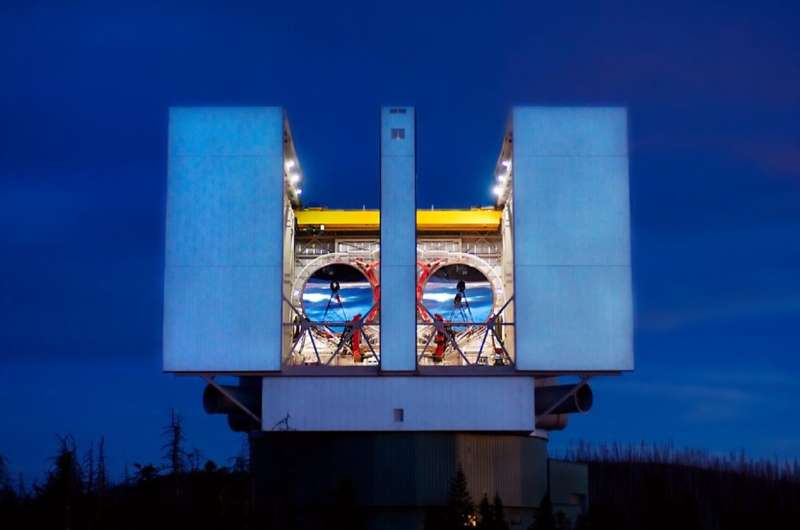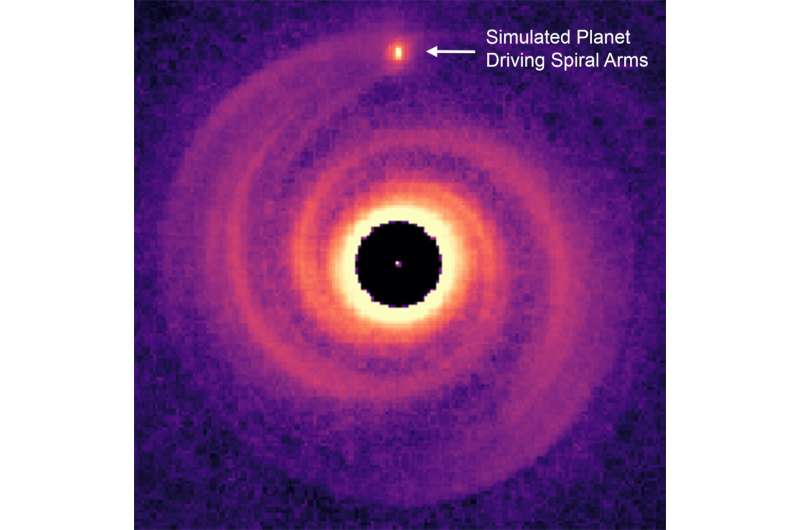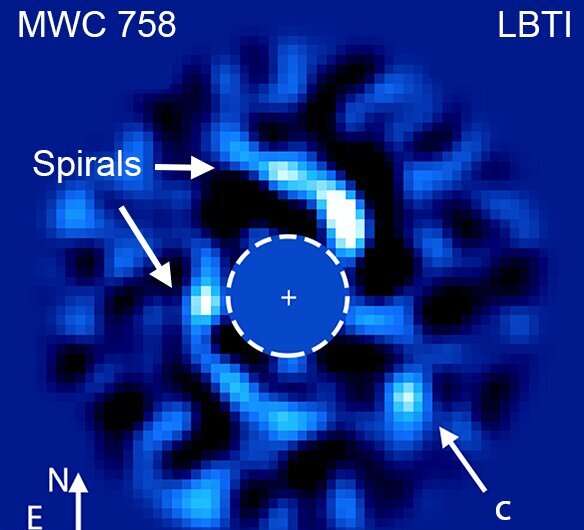This article has been reviewed according to Science X's editorial process and policies. Editors have highlighted the following attributes while ensuring the content's credibility:
fact-checked
peer-reviewed publication
trusted source
proofread
Astronomers discover elusive planet responsible for spiral arms around its star

Depictions of the Milky Way show a coiling pattern of spiral "arms" filled with stars extending outward from the center. Similar patterns have been observed in the swirling clouds of gas and dust surrounding some young stars—planetary systems in the making.
These so-called protoplanetary disks, which are the birthplaces of young planets, are of interest to scientists because they offer glimpses into what the solar system may have looked like in its infancy and into how planets may form in general. Scientists have long thought that spiral arms in these disks could be caused by nascent planets, yet none had been detected until now.
In a paper published in Nature Astronomy, University of Arizona researchers report the discovery of a giant exoplanet, dubbed MWC 758c, that may be generating the spiral arms in its infant planetary system. The astronomers also propose possibilities as to why scientists have struggled to find this planet in the past, as well as how their methods may apply to detecting other concealed planets in similar circumstances.
"Our study puts forward a solid piece of evidence that these spiral arms are caused by giant planets," said Kevin Wagner, lead author of the paper and a postdoctoral researcher at the University of Arizona Steward Observatory. "And with the new James Webb Space Telescope, we will be able to further test and support this idea by searching for more planets like MWC 758c."
The planet's star is located about 500 light-years away from Earth and is only a few million years old—an embryo compared to our own 4.6-billion-year-old sun. Hence, the system still has a protoplanetary disk, as it takes about 10 million years for the circling debris to either be ejected out of the system, ingested by the star, or formed into planets, moons, asteroids and comets. The prominent spiral pattern in this system's debris was first discovered in 2013, and astronomers were quick to point out the connection to theoretical simulations of forming giant planets.
"I think of this system as an analogy for how our own solar system would have appeared less than 1% into its lifetime," Wagner said. "Jupiter, being a giant planet, also likely interacted with and gravitationally sculpted our own disk billions of years ago, which eventually led to the formation of Earth."
Astronomers have imaged most of the protoplanetary disks in stellar systems that are visible using current telescopes. Out of about 30 identified disks, around one-third feature spiral arms—prominent swirls within the gas and dust particles of the disk.

"Spiral arms can provide feedback on the planet formation process itself," Wagner said. "Our observation of this new planet further supports the idea that giant planets form early on, accreting mass from their birth environment, and then gravitationally alter the subsequent environment for other, smaller planets to form."
Spiral arms are generated due to the orbiting companion's gravitational pull on the material orbiting the star. In other words, the presence of a massive companion, such as a giant planet, was expected to trigger the spiral pattern in the disk. However, previous attempts to detect the responsible planet have turned up empty—until now.
"It was an open question as to why we hadn't seen any of these planets yet," Wagner said. "Most models of planet formation suggest that giant planets should be very bright shortly after their formation, and such planets should have already been detected."
The researchers were finally able to detect MWC 758c by using the Large Binocular Telescope Interferometer, or LBTI, a UArizona-built instrument connecting the telescope's two 8.4-meter primary mirrors that can observe at longer wavelengths in the mid-infrared range, unlike most other instruments used for observing exoplanets at shorter, or bluer, wavelengths. According to Steve Ertel, a co-author on the paper and LBTI lead instrument scientist, the instrument has a camera that can detect infrared light in a similar manner to NASA's James Webb Space Telescope, or JWST.
Even though the exoplanet is estimated to be at least twice the mass of Jupiter, it was invisible to other telescopes because of its unexpected red color—the "reddest" planet ever discovered, Ertel said. Longer, redder wavelengths are more difficult to detect than shorter wavelengths because of the thermal glow of Earth's atmosphere and the telescope itself. The LBTI is among the most sensitive infrared telescopes yet constructed and due to its larger size, can even outperform JWST for detecting planets very close to their stars, such as MWC 758c.
"We propose two different models for why this planet is brighter at longer wavelengths," Ertel said. "Either this is a planet with a colder temperature than expected, or it is a planet that's still hot from its formation, and it happens to be enshrouded by dust."
"If there is a lot of dust surrounding this planet, the dust will absorb shorter wavelengths, or bluer light, making the planet appear bright only at longer, redder wavelengths," said co-author Kaitlin Kratter, a UArizona theoretical astrophysicist. "In the other scenario of a colder planet surrounded by less dust, the planet is fainter and emits more of its light at longer wavelengths."

Wagner said large amounts of dust in the planet's vicinity may tip off that the planet is still forming, and that it might be in the process of generating a system of moons like the Jovian moons around Jupiter. On the flip side, if the planet follows the colder model, there might be something going on in these early stellar systems that causes planets to form colder than expected, prompting planetary scientists to revise their planet formation models and exoplanet detection strategies.
"In either case, we now know that we need to start looking for redder protoplanets in these systems that have spiral arms," Wagner said.
The astronomers anticipate that once they observe the giant exoplanet with the James Webb Space Telescope, they will be able to make a judgment call as to which of the two scenarios is playing out in the infant system. The team has been granted time to use JWST in early 2024 to complete these observations.
"Depending on the results that come from the JWST observations, we can begin to apply this newfound knowledge to other stellar systems," Wagner said, "and that will allow us to make predictions about where other hidden planets might be lurking and will give us an idea as to what properties we should be looking for in order to detect them."
More information: Direct images and spectroscopy of a giant protoplanet driving spiral arms in MWC 758, Nature Astronomy (2023). DOI: 10.1038/s41550-023-02028-3 , www.nature.com/articles/s41550-023-02028-3
Journal information: Nature Astronomy
Provided by University of Arizona





















